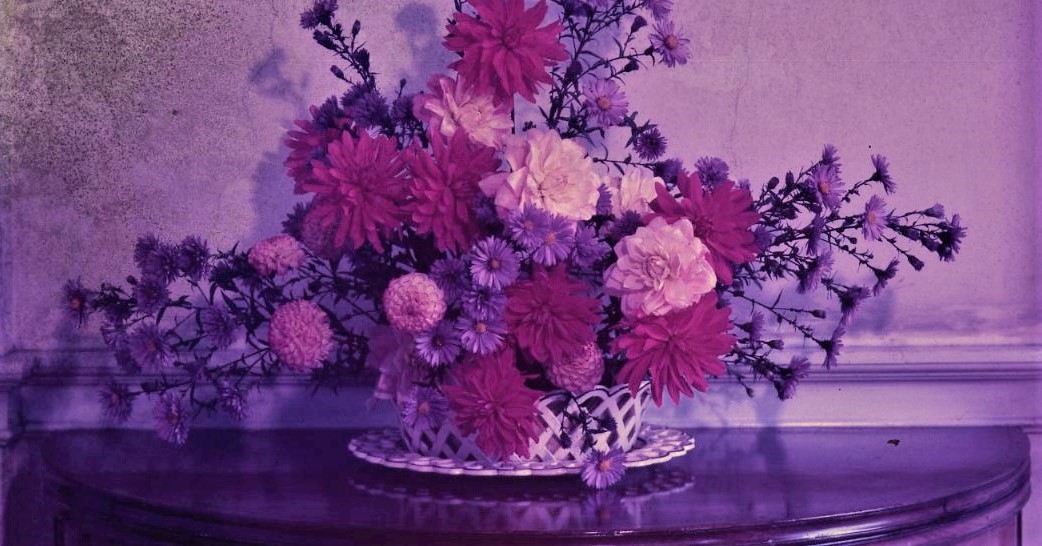Constance Villiers Stuart: Lessons in Flower Arranging
STORIES


![]()

Alice Ridgway, Interim Project Archivist
My childhood fear of flower arranging has been summoned by a photograph of Constance Villiers Stuart, standing proudly next to an imposing floral display. I am being told off by my grandmother for sticking my fingers into green floral foam. As a fidgety five-year-old, the soft yet crunchy substance was an irresistible toy. I had crushed it beyond recognition and rendered it useless for the church’s Sunday display. Leafing through the envelopes of kodak transparencies, I noticed that Constance’s arrangements left more room for fun and experimentation than my own memories of the church displays. Asymmetry, fallen petals, bold receptacles, and accompanying trinkets were all features of her compositions. No flowers were deemed garish or inappropriate. Common cottage plants like fuchsias sat beside majestic dahlias.



The Garden Museum has recently been gifted the archive of Constance Villiers Stuart. Research sketchbooks of her Indian escapades informing the influential book Gardens of the Great Mughals sit beside photographs of flower arrangements. Many of us are more familiar with the floral displays of Constance Spry than Villiers Stuart. However, an enduring interest in flower arranging comprises a considerable part of the Constance Villiers Stuart archive. Mary Ann Prior’s recent book Constance Villiers Stuart in Pursuit of Paradise pointed me towards the Country Life articles that now reside in our archive. Constance championed the art of flower arranging in these columns, suggesting it was a new career option for women that offered more scope for individual expression than the office typewriter. She stated that the curves and accidental shapes of flower arranging provided relief from the ‘logical severity of modern architecture.’ Constance devoted years of her life to the art of flower arranging. She lectured on its core principles and studied the complex Japanese art of Ikebana, but she always left room for rule-breaking and creative outlet. Below are some of her concise tips from the archive that offer insight for budding arrangers today.

- Consider the Complete Picture
Flowers must contrast and harmonise with the room. Look to nature for inspiration, the blue sea contrasts with yellow sand, whilst the woods in autumn create a beautiful warm harmony. Do not be afraid of vivid colours, embrace brilliant combinations such as scarlet, lemon and orange.
- Form Matters
Form is important and often overlooked. An easy rule to ensure success is to have the flowers at least one and a half times the height of the vase. Look to architecture to learn the rules of form and balance.
- Work from High to Low
Place the highest spray first to anchor the most vital elements of the display. Fill in the gaps with the rest of your flowers. Have fun with extra elements, a scattering of petals or draping foliage adds interest.
- Fresh is Best
Flowers must have fresh water every day. Use the freshest flowers available and pick them from your garden if possible.
- Keep a Hammer Handy
‘A hammer in the garden is as useful as scissors.’ Bash flower stems with a hammer to break down the fibres and aid water consumption. It is quicker and easier than cutting the stem with scissors.

Flower arranging at my grandmother’s church, St Luke’s in Stoke Hammond, was a serious business. It operated with codes of conduct that I did not understand. Some flowers were unlucky, some flowers were tasteless and other flowers, like lilies, did not belong in a church (unless there was a funeral.) To me, it was an intimidating and unapproachable art form that I both feared and respected. Constance’s advice may sound curt; however, I take comfort in her certainty and pragmatism that encourages individual expression and playfulness. It inspired me to break the Sunday church display rules and make my own Constance-inspired arrangement.
